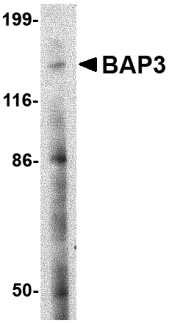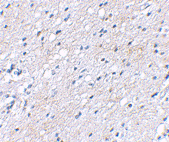Catalog# :4503
BRAL1 is a member a superfamily consisting of several highly homologous hyaluronan and proteoglycan binding link proteins. BRAL1 is predominantly expressed in brain tissue and spinal cord. Like other members in the link-module superfamily, BRAL1 contains an immunoglobulin-like fold and two proteoglycan tandem repeats (PTRs). Its mRNA expression pattern is similar to other lectican proteoglycans, suggesting that BRAL1 may act to stabilize the binding between the extracellular matrix molecule hyaluronan and brevican. Immunostaining of mouse brain showed BRAL1 expression at P20 in the white matter of the developing cerebellum and in myelinated fiber tracts in the adult brain, suggesting that expression starts when axonal myelination occurs.
Additional Names : BAP3 (NT), BAI1-associated protein 3, BAIAP3

Description
Left: Western blot analysis of BAP3 in SK-N-SH cell lysate with BAP3 antibody at 2 µg/ml.
Below: Immunohistochemical staining of human brain tissue using BAP3 antibody at 2.5 µg/ml.
Other Product Images
 Source :BAP3 antibody was raised against a 12 amino acid peptide from near the amino terminus of human BAP3.
Source :BAP3 antibody was raised against a 12 amino acid peptide from near the amino terminus of human BAP3.Purification : Affinity chromatography purified via peptide column
Clonality and Clone : This is a polyclonal antibody.
Host : BAP3 antibody was raised in rabbit.
Please use anti-rabbit secondary antibodies
Application : BAP3 antibody can be used for the detection of BAP3 by Western blot at 2 µg/ml.
Tested Application(s) : E, WB, IHC
Buffer : Antibody is supplied in PBS containing 0.02% sodium azide.
Blocking Peptide :Cat.No. 4503P - BAP3 Peptide
Long-Term Storage : BAP3 antibody can be stored at 4ºC, stable for one year. As with all antibodies care should be taken to avoid repeated freeze thaw cycles. Antibodies should not be exposed to prolonged high temperatures.
Positive Control :
1. Cat. No. 1220 - SK-N-SH Cell Lysate
Species Reactivity : H
GI Number : 3929917
Accession Number : BAA34710
Short Description : (NT) BAI1-associated protein 3
References
1. Shiratsuchi T, Oda K, Nishimori H, et al. Cloning and characterization of BAP (BAI-associated protein 3), a C2 domain-containing protein that interacts with BAI1. Biochem. Biophys. Res. Comm. 1998; 251:158-65.
2. Palmer RE, Lee SB, Wong JC, et al. Induction of BAIAP3 by the EWS-WT1 chimeric fusion implicates regulated exocytosis in tumorigenesis. Cancer Cell 2002; 2:497-505.

No comments:
Post a Comment